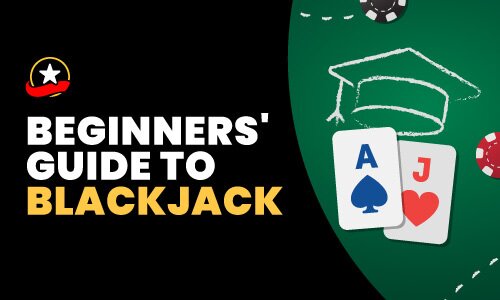
Blackjack is arguably the most popular casino game of all time.
Perhaps the reason it’s so beloved is that the rules are easy to learn, and with a little know-how, you can bring the house edge down to the lowest in the casino.
It’s a simple game at face value. The basis is to beat the dealer’s hand by getting closer to 21 without going over. A hand equal to 22 or more is bust and loses the round.
It gets a lot deeper once you incorporate various strategies and money management techniques.
So, where do you begin? This beginner’s guide to blackjack is the ultimate guide on how to play. Whether you’re new to the game or just want a crash course refresher, you will find all the information you need here.
Blackjack Beginner’s Guide
Card Values In Blackjack
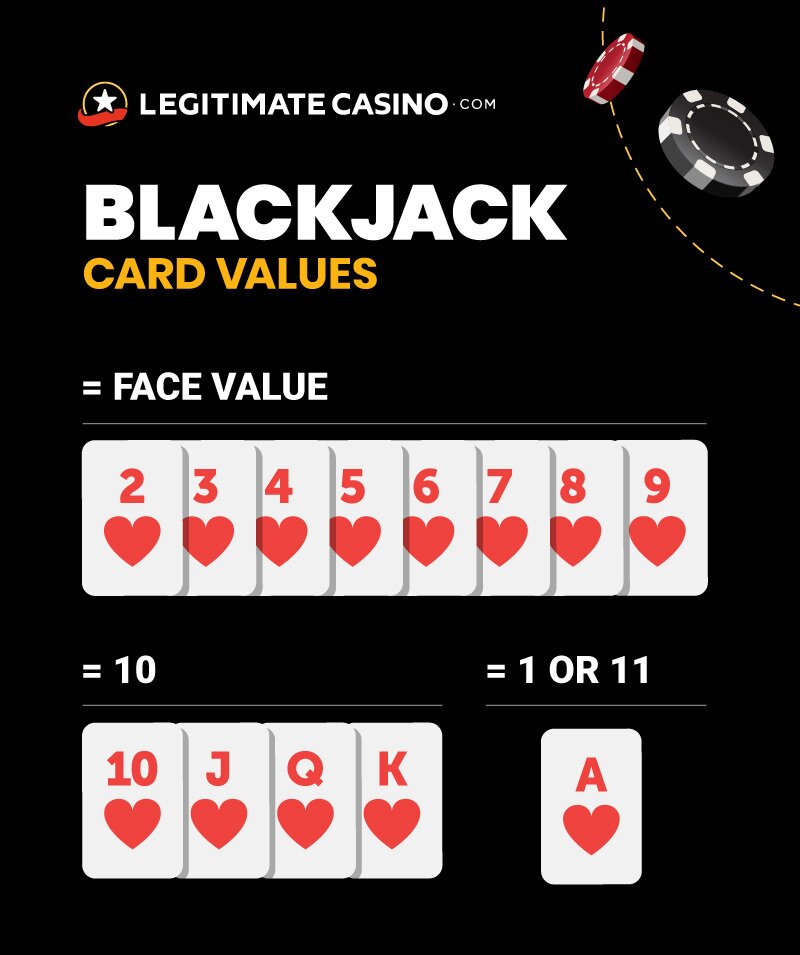
Let’s start with the basics. There are 52 cards in a traditional deck consisting of the numbers 2-10, the Ace, and three face cards: Jack, Queen, King.
That means there are thirteen of each suit: hearts, diamonds, clubs, and spades. However, the suits typically don’t matter in this game, so don’t worry about them.
In blackjack, the numbered cards equal their value. A four is worth four, and a six is worth six. However, the face cards, J, Q, and K, all count as ten. The Ace is unique since it can be a one or an eleven depending on your cards.
The two cards in your hand get added together for your total. For example, an 8 and a Jack would equal 18. An eight and an Ace can equal 19 or 9, depending on how you want to use it.
Soft Vs. Hard Hands
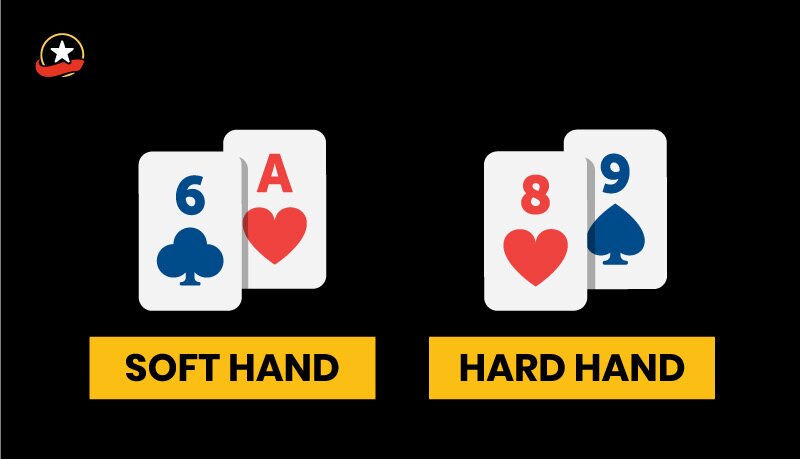
- A hard hand is one that does not contain an Ace. It’s hard because its values are fixed.
- A soft hand is one that does have an Ace. Think of it as malleable since you can use the Ace as a one or an eleven.
The difference between these two types of hands is pretty straightforward but crucial when it comes to determining your next move.
Learning How To Play: A Quick Blackjack Guide
Now that we’ve established the basics of the deck let’s examine the process of the game. Below is a step-by-step guide to how a round gets played out.
Place Your Initial Bet
Place your wager in the betting area in front of your chip stack before the cards get dealt. The wagering minimums and maximums vary from table to table.The Cards Get Dealt
Everyone receives two cards, including the dealer. All players’ cards get face-up cards while the dealer has one face-up and one face-down. The dealer’s face-down card is called the hole card.Make Your Call
Once you’ve seen your hand, it’s time to decide what your next move is. You can hit, stand, surrender, double down, or take insurance.The Dealer Plays His Hand
After everyone plays their hand, it’s the dealer’s turn to play through theirs. They must follow the table rules, so there is no subjectivity. If the dealer’s hand is 16 or lower, they must hit. The rules for hitting on a soft or hard 17 vary by table.Losses and Wins Get Determined
If you beat the dealer, your payout is 1 to 1, unless you got a natural blackjack, in which case your payout is 3:2 or 6:5 depending on the table rules. If the dealer beats your hand or if you bust, you lose. A tie is called a push, and no one wins or loses any money.
Advanced Betting Options & Side Bets
Until you’ve become a seasoned player, it’s best to stick to the basics. However, we will go over some of the more advanced betting options so you know what they are and when to use them.

Split: When you get two of a kind in blackjack, you have the option to split your hand into two hands. That means you must also double your wager, so you should only split when it’s mathematically beneficial.
Each of your hands gets played separately, allowing you to use two different strategies based on the cards.

Surrender: If you get a bad hand, surrendering sacrifices half your bet instead of losing the whole thing. There are two versions of this rule. You can early surrender when the dealer’s up-card is showing, but they haven’t checked their hole card yet.
The late surrender happens after the dealer checks their hole card, and you only get half your bet back if the dealer doesn’t have blackjack.
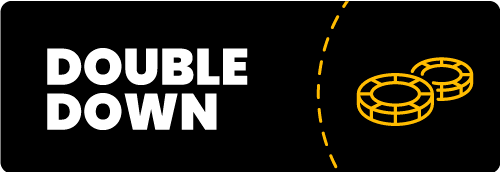
Double Down: After you get your first two cards, you can choose to double your bet. That means you only get one more card, and you won’t be able to hit again for the round.
If your hand doesn’t beat the dealer’s, you lose all of your bet. Despite the added risk, there are certain situations where it’s statistically likely you will win.

Insurance: You can take an insurance bet when the dealer’s up-card is an Ace. This move protects you if their hole card is a ten giving them a natural blackjack.
You must wager half your original bet. If it works in your favor, it pays back 2 to 1, so you break even instead of losing.
Although it sounds good in theory, we never advise taking insurance.
The Blackjack Table
The first time at a blackjack table can be a little intimidating. The rules are laid out before you, but it’s wise to understand what they mean. Before bellying up to the felt, read the details below.
What’s Written On The Blackjack Table?

- Blackjack Pays 3 to 2: This number, sometimes written as a ratio of 3:2, shows you what a natural blackjack win pays. That means you will get $3 for every $2 you wager.
- Dealer must stand on 17 and must draw to 16: That states that the dealer’s hand will hit on 16 and anything lower, and they won’t hit on 17. The rules also tell whether the dealer hits on soft or hard 17s.
- Insurance pays 2 to 1: That applies to the insurance bet. Should you choose to take it, you will get paid out 2 to 1.
- Max/Min Bets: The maximum and minimum bets are displayed on a sign or digital screen sitting on the felt. They let you know the least amount of money is required to play a hand and the largest amount you can wager at once.
Blackjack Strategy Guide
Blackjack is an approachable game for beginners, but a basic understanding of strategy will help you win the big bucks.
Each hand has an ideal mathematical move, and following it decreases the house edge significantly.
Luckily you don’t have to memorize the best play for every situation. This chart takes the guesswork out of everything.
How To Use This Chart As A Cheat Sheet
The left column shows your hand, and the dealer’s up-card is displayed across the top row. Follow both of them to meet in the middle at your conclusion.
For example, you should double down if your hand is a soft 18 and the dealer’s up-card is a 6. However, you should stand if your hand is a soft 18 and the dealer’s up-card is a 7.
Click on the image to enlarge or save and print your strategy chart for the next time you play a blackjack game.
Top 10 Tips For Blackjack Beginners
Everyone wants to be a pro, but let’s face it, that takes a lot of practice, and it won’t happen overnight. Here are a few tips for beginners that will help get you ahead.
- Learn basic strategy: You don’t have to be an expert, but knowing a few basics about strategy will help you play your best at your current level.
- Stick to games that pay the full 3:2 for a blackjack: Games that are 6:5 pay back $6 for your $5, meaning the house edge increases to 2%.
- Pick the table with the best rules: Don’t play a game that puts you at a bigger disadvantage before you even start. You have total control over what table you sit down at, so choose ones with better rules.
- Fewer decks are better: Fewer decks means a lower house edge. The probability of getting a blackjack decreases with the more decks that are added.
- Don’t take insurance: Statistically, you are likely to lose the insurance bet. There is seldom a situation where it’s advisable.
- Don’t stand on your soft 17: Since the Ace works as a one or an eleven, you can’t bust with a soft 17. Always hit.
- Don’t overuse the surrendering option: There are situations when it’s in your best interest to surrender, but that’s not always the case. Referencing the chart will help you know when to avoid this move.
- Don’t split a hand of two 10s: Two tens puts you in a great position at 20 points. You can’t get much closer to 21, and splitting them puts you at risk of getting two weaker hands.
- Don’t let your bet size decide your bet: Always play with the best strategy at the front of your mind, not the size of the bet.
- Don’t make decisions based on gut feelings: Avoid getting caught up in the moment or letting your emotions take over. Make decisions based on logic and your bankroll limits.
Blackjack Betting Strategies
There are a few blackjack betting strategies that some players use, both when playing online blackjack and when playing at a brick-and-mortar casino. They attempt to maximize a winning streak or recover losses but can require a large bankroll. It’s always best to stick to what makes you the most comfortable.
- Positive betting strategy: This is the method of increasing your bet once you win a hand and continuing to do so until you lose. Then you go back to your original bet size until you win again and repeat.
- Negative betting strategy: This is only for those comfortable with spending a larger bankroll. You play a consistent bet until you lose, at which point you make a larger wager in an attempt to regain your losses.
- Flat betting: Most players flat bet, which is placing a wager as you normally would without letting wins or losses affect you.
Blackjack House Edge
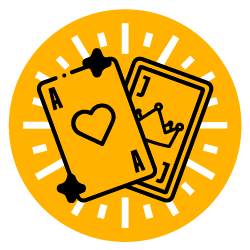
The house edge is the percentage of each wager that the casino wins on average over time. Without basic blackjack strategies, this number is 2% or greater. By using the chart and playing by the math, blackjack can have the lowest house edge of all casino games at around 0.5%.
For further comparison, let’s say you’re playing blackjack and giving the house 2% by not using strategy.
- If you’re wagering $200 an hour, everything considered, the casino is getting $4 off of you.
- On the other hand, if you use the cheat sheet and get the house edge down to 0.5%, you only lose $1 per hour.
It may not seem like a huge difference, but losing at least four times faster cuts into your bottom line pretty quickly.
As you can see, the smaller that percentage is, the better it is for you. Keep in mind that the house edge can vary with the table’s rules and amount of decks in play.
Top Low House Edge Blackjack Games You Can Play Online
Practice Makes Perfect: Play Blackjack For Free
| Bonus: 100% up to $5,000 | Play At Wild Casino |
Want To Learn More About Blackjack?
Blackjack Frequently Asked Questions
Yes. In fact, blackjack is one of the easiest table games to learn and with a little knowledge, you can increase your chances of winning. Read our step-by-step blackjack guide and you’ll be playing in no time at all.
The main goal in blackjack is to beat the dealer’s hand and try to reach 21 without going over.
The best way to win is to learn basic strategies. Using basic strategy will help you reduce the house edge and improve your chances of earning a win.
It’s common to hit on 8 or lower and stand on 12 or higher, but other factors can come into play. Your best bet is to use the strategy chart on this page.















